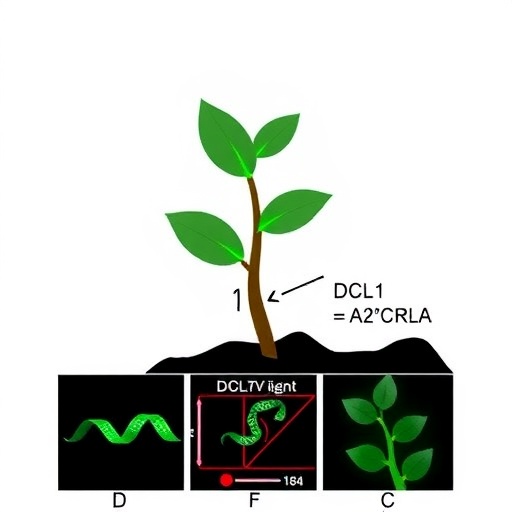In the intricate world of plant molecular biology, the enzyme DICER-LIKE 1 (DCL1) stands as a linchpin in the regulation of gene expression through its pivotal role in microRNA (miRNA) biogenesis. These miRNAs, typically 20 to 22 nucleotides in length, are key post-transcriptional regulators that govern widespread biological processes, from development to stress responses. Despite DCL1’s essential function in processing precursor miRNAs into their mature forms, the RNA cues that direct its precise cleavage site selection have eluded comprehensive characterization—until now.
A revolutionary study conducted by Le and colleagues has unveiled critical insights into how DCL1 interprets complex RNA structures to execute its cleavage operation with remarkable specificity. Using an innovative high-throughput sequencing approach, the research team analyzed a staggering database of over 46,000 short hairpin RNA sequences, originally examined with the human analog DICER, to probe the cleavage preferences of Arabidopsis thaliana DCL1. This approach allowed for an unprecedented global view into the molecular determinants that influence where and how DCL1 cleaves its RNA substrates.
Central to this discovery is the identification of a novel RNA structural and sequence element dubbed the GHR motif. This motif emerges not just as a passive feature but as a decisive molecular beacon guiding DCL1’s cleavage decisions. Interestingly, its influence operates independently of DCL1’s well-characterized double-stranded RNA-binding domains and helicase modules. Instead, the GHR motif exerts its effect primarily through the RNase IIIDa domain, the enzymatic heart of DCL1 responsible for cleaving the RNA backbone. This finding redraws previous assumptions about domain interplay within DCL1, emphasizing the nuanced mechanistic layers governing RNA processing.
What is particularly striking about the GHR motif is its evolutionary conservation across a broad spectrum of plant species. This conservation underscores its fundamental biological importance and suggests that the motif’s role in guiding DCL1 is a deeply entrenched feature in plant miRNA maturation pathways. The precise cleavage enabled by the GHR motif is vital for the generation of functionally competent miRNAs, which in turn modulate gene networks with extraordinary finesse.
Beyond canonical miRNA processing, the study also ventures into the realm of non-canonical 22-nucleotide miRNAs, a class known to trigger secondary silencing cascades and amplify gene regulatory signals. The GHR motif’s involvement in the biogenesis of these specialized miRNAs indicates that its functional repertoire is broader than previously imagined, extending its influence to the nuanced layers of post-transcriptional regulation that govern plant adaptation and survival.
The implications of these findings resonate far beyond basic science. By delineating the molecular grammar that orchestrates DCL1 cleavage specificity, this work opens avenues toward engineering miRNA pathways with precision. Such advancements may empower crop scientists to finely tune gene expression profiles, enhancing traits like stress tolerance, yield, and developmental timing in agriculturally important plants.
Moreover, the study’s methodology exemplifies the power of leveraging high-throughput sequencing combined with model system cross-referencing. By repurposing a vast dataset originally curated from human DICER studies to interrogate plant DCL1, the authors bridge evolutionary and functional domains, revealing conserved and divergent principles of RNA processing enzymes. This cross-kingdom perspective enhances our understanding of RNA biology’s universality and specificity.
From a technical standpoint, the researchers employed an analytical framework that integrated RNA structural motif identification with cleavage site mapping at nucleotide resolution. Such integration allowed them to decouple the contributions of primary sequence and higher-order RNA structures in directing enzymatic activity. It was through this lens that the GHR motif was discerned, highlighting the synergistic role of sequence and shape in RNA–protein interactions.
Furthermore, the independence of the GHR motif’s influence from known RNA-binding and helicase domains suggests that DCL1 may harbor allosteric or context-dependent regulatory mechanisms within its RNase domains. This allosteric regulation could provide a flexible means for the enzyme to accommodate diverse RNA substrates and maintain cleavage precision, an aspect that warrants further structural and biophysical investigation.
The conservation of the GHR motif across plant taxa raises compelling evolutionary questions. It posits that selective pressures have preserved this RNA element to ensure fidelity in miRNA processing, reflecting the centrality of miRNA-mediated control in plant gene regulatory networks. Such evolutionary insights enrich our understanding of the molecular co-evolution of enzymes and their RNA targets.
Additionally, the study’s identification of the GHR motif contributes to the broader narrative of how RNA secondary structures influence RNA processing enzymes. While much research has focused on proteins reading linear sequences, it is becoming increasingly clear that the three-dimensional architecture of RNA profoundly impacts enzymatic functions. The GHR motif embodies this principle, acting as a structural signature that directs enzymatic cleavage beyond primary sequence cues.
In practical terms, elucidating the determinants of DCL1 cleavage specificity has tremendous potential for synthetic biology. The design of artificial miRNA precursors or RNA-based regulatory circuits could benefit from embedding GHR-like motifs to achieve predictable and efficient processing outcomes. Such precision engineering could revolutionize plant biotechnology.
Finally, the revelation that GHR involvement extends to non-canonical 22-nucleotide miRNAs enhances our comprehension of the biogenesis pathways of these molecules, which serve as key triggers of RNA silencing amplification. Understanding how DCL1 discriminates among substrate classes through motifs like GHR could unlock new strategies for modulating gene silencing intensity and duration in plants.
Altogether, this landmark study by Le et al. profoundly enriches the landscape of plant RNA biology. It illuminates the complex interplay between RNA sequence, structure, and enzymatic recognition that defines the specificity of one of the central actors in plant post-transcriptional regulation. As we continue to unravel these molecular mysteries, such knowledge will propel forward both fundamental science and agricultural innovation, promising a future where the precise editing of gene expression circuits is as natural as the plants themselves.
Subject of Research: RNA elements influencing DICER-LIKE 1 (DCL1) cleavage specificity in plant microRNA biogenesis.
Article Title: Key RNA elements influencing DCL1 cleavage in plant microRNA biogenesis.
Article References:
Le, T.NY., Nguyen, T.D., Yu, Y. et al. Key RNA elements influencing DCL1 cleavage in plant microRNA biogenesis.
Nat. Plants (2025). https://doi.org/10.1038/s41477-025-02067-w
Image Credits: AI Generated




